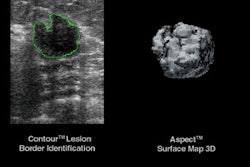Combining ultrasound with tissue plasminogen activator (tPA) therapy appears to significantly enhance outcomes for patients with acute ischemic stroke, researchers reported at the 2002 International Stroke Conference in San Antonio.
"We started down this path unexpectedly," said lead researcher Dr. Andrei Alexandrov, assistant professor of neurology at the University of Texas Medical Center in Houston. Alexandrov presented Phase I data from a study called Combined Lysis of Thrombus in Brain Ischemia with Transcranial Ultrasound and Systemic TPA (CLOTBUST).
"We use low frequency transcranial Doppler (ultrasound) with patients presenting stroke symptoms in the emergency room who received tPA treatment. Emergency room nurses began seeing remarkable differences in improvements between patients getting tPA with ultrasound and those who hadn't. They told us about it, calling our attention to what they were seeing. So we decided to do a multi-center, blind, randomized clinical trial, which is now ongoing," Alexandrov said.
In this study, Alexandrov and his team used ultrasound (TCD 100M, Spencer Technologies, Seattle, WA) to determine rates of recanalization and recovery outcomes in patients who received a combination of intravenous tPA 0.9 mg/kg with 2-MHz frequency ultrasound. The mean age of the subjects was 69 years.
Alexandrov created an ultrasound device held in a frame like "the one you see inside a construction worker's hard hat," he said. He aimed the ultrasound at the clot for an hour while tPA was infused. He continued to track the clot with ultrasound for an hour after each tPA infusion ended.
The researchers used ultrasound to monitor the residual flow signals with the Thrombolysis in Brain Ischemia (TIBI) flow grading system. Treating physicians obtained NIH Stroke Scale (NIHSS) scores independently of TCD results.
Primary outcome measurements were complete arterial recanalization at 2-24 hours and a 4-5 TIBI grade. Recovery was deemed dramatic if the total NIHSS score was 3 or less, or early if the reduction by NIHSS was of 10 points or greater. The safety end point was symptomatic intracerebral hemorrhage within the first 72 hours after stroke onset.
Among 55 patients treated within two hours of acute ischemic stroke, complete recanalization occurred in 36% of the patients. Dramatic recovery occurred in 27% of patients at two hours, and in 31% at 24 hours. Improvements correlated to early recanalization. The intracerebral hemorrhage rate was 9%.
"Use of this level of ultrasound with tPA treatment appeared to enable fast patient recovery in the emergency room in about every fourth patient. And we proved that ultrasound is safe when used in this way," Alexandrov said.
Dr. Gregory del Zoppo of Scripps Research Institute in La Jolla, CA commented that "it's no secret that you can break up clots with ultrasound. But safety is the real issue," he added. "You can also break up the brain with ultrasound."
Alexandrov said that Phase II study is focused on the optimal ultrasound frequency for this treatment. Forty-one subjects have been treated in the Phase II study, with the research team hoping to enroll a total of 136. Currently, four medical centers in the U.S. and Canada are involved in the CLOTBUST trial.
By Bruce SylvesterAuntMinnie.com contributing writer
March 1, 2002
Related Reading
Diffusion and perfusion MRI may guide thrombolysis in stroke, January 31, 2002
Stroke strategy improves outcomes, cuts costs, January 9, 2002
CT-based assessment may help select stroke treatment, November 13, 2001
Genentech gets approval for Cathflo Activase, September 6, 2001
MRI identifies patients at risk of hemorrhagic transformation after stroke, April 23, 2001
Copyright © 2002 AuntMinnie.com


















